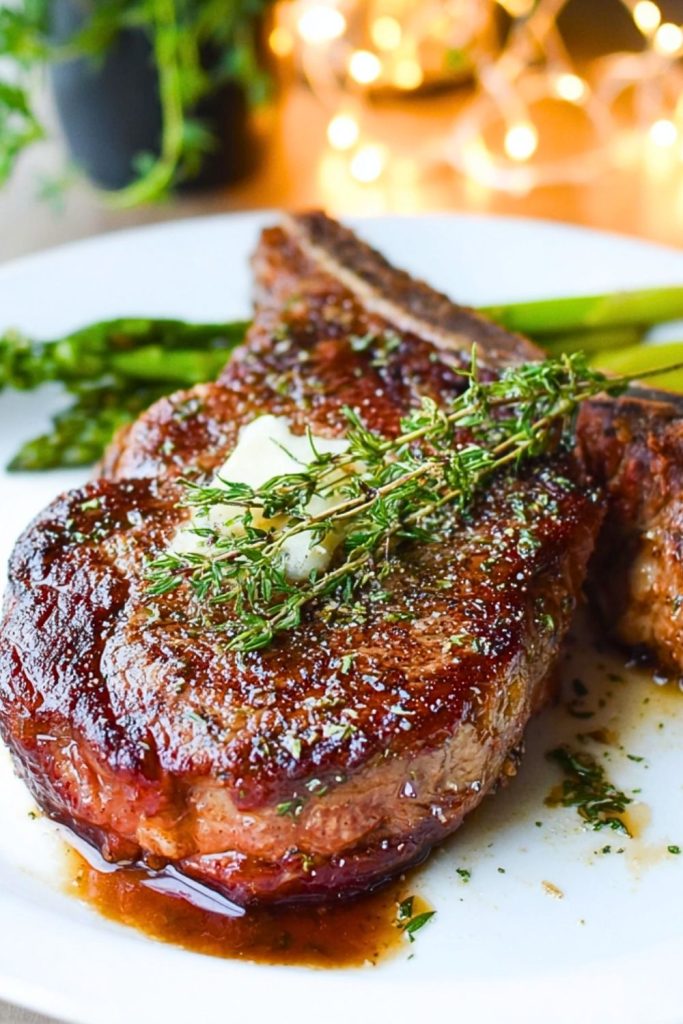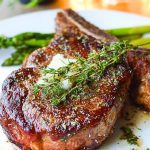I’ve made a lot of steaks in my kitchen, but the method I keep coming back to—especially when I want consistent, tender, and deeply flavorful results—is cooking steak in the oven. It’s straightforward, surprisingly quick, and gives you the flexibility to focus on sides or simply relax while your steak finishes to juicy perfection. That golden sear, combined with a slow finish in the oven, creates a restaurant-quality steak right at home.

I love how this method delivers a steak that’s beautifully browned on the outside while remaining tender and perfectly pink inside. Whether it’s date night, a cozy dinner, or just treating myself on a weeknight, oven-cooked steak always hits the spot. Let me show you how to get it just right.
Why You’ll Love This Steak in the Oven
This technique brings out the best in your steak without the stress of managing grill temps or flare-ups. It’s ideal for any cut, delivers reliable doneness every time, and allows for layering flavors like garlic butter, herbs, or wine-based sauces. Plus, no need to stand outside—it’s an all-weather steak solution that makes every bite count.
What Cut of Steak Works Best in the Oven?
When it comes to cooking steak in the oven, not all cuts are created equal—but the good news is that many popular choices work beautifully with this method. My personal favorites are ribeye, New York strip, and filet mignon. These cuts are thick enough to develop a beautiful sear without overcooking in the center, and they carry enough marbling to stay juicy through the oven finish.
T-bone and porterhouse are also excellent if you’re cooking for a hearty appetite, while sirloin or top round can work well too with careful attention to doneness and resting time. Just be sure to choose steaks at least 1 to 1½ inches thick for the best results.
Options for Substitutions
Cooking steak in the oven is quite adaptable, especially if you’re working with what you have. Here are a few smart substitutions you can try:
- Butter substitute: Use ghee or olive oil if you prefer a dairy-free finish.
- Fresh herbs: If thyme or rosemary isn’t available, dried herbs can stand in—just use about one-third the amount.
- Garlic cloves: Swap for garlic powder in a pinch, though the fresh kind offers more depth.
- Cast iron skillet: No cast iron? Use any oven-safe skillet or even a heavy-duty baking sheet—but be sure it can handle high searing heat.
- Steak sauce alternative: Skip the sauce entirely and finish with compound butter or a splash of balsamic glaze.
These swaps won’t compromise the deliciousness—you’ll still get a rich, savory steak full of character.
Ingredients for This Steak in the Oven
- Steak (Ribeye, New York Strip, or Filet Mignon)
The star of the show—choose a thick-cut, well-marbled steak for maximum juiciness and flavor. - Kosher Salt
A generous seasoning is key. Salt enhances the natural flavor of the meat and helps create a delicious crust. - Freshly Ground Black Pepper
Adds a punch of spice and balances the richness of the steak. - High-Heat Cooking Oil (like avocado or canola oil)
Essential for searing—these oils can handle the heat without smoking too quickly. - Butter
Adds richness and a silky finish when melted over the steak as it rests. - Fresh Thyme or Rosemary
These herbs infuse the butter and steak with earthy aroma and flavor during the oven roast. - Garlic Cloves (crushed)
Used whole in the pan to subtly flavor the steak as it cooks, especially during the oven phase.
These simple, high-impact ingredients work together to build layers of deep, satisfying flavor with minimal effort.

Step 1: Bring the Steak to Room Temperature
Take your steak out of the fridge about 30–45 minutes before cooking. This helps it cook more evenly and gives a better sear.
Step 2: Preheat Your Oven
Set your oven to 400°F (200°C). Meanwhile, place a cast iron skillet on the stove and heat it over high heat until it’s smoking hot.
Step 3: Season Generously
Pat the steak dry with paper towels, then season both sides liberally with kosher salt and freshly ground black pepper. Don’t be shy—this forms that crave-worthy crust.
Step 4: Sear the Steak
Add oil to the hot skillet, then carefully place the steak in. Sear for 2–3 minutes per side without moving it around, until a deep golden-brown crust forms.
Step 5: Add Butter, Garlic & Herbs
Once the steak is seared, reduce the heat slightly and add butter, smashed garlic, and herbs to the skillet. Spoon the melted butter over the steak for 30 seconds.
Step 6: Transfer to the Oven
Slide the skillet into the preheated oven. Cook for 5–7 minutes for medium-rare, depending on steak thickness and desired doneness. Use a meat thermometer for precision.
Step 7: Rest Before Serving
Remove the steak from the oven and place it on a cutting board. Tent it loosely with foil and let it rest for 5–10 minutes to let the juices redistribute.
How Long to Cook the Steak in the Oven
After searing, the steak generally needs 5 to 7 minutes in a 400°F (200°C) oven to reach medium-rare, depending on thickness. Use these temperature guidelines for doneness:
- Rare: 120–125°F (49–52°C)
- Medium-rare: 130–135°F (54–57°C)
- Medium: 140–145°F (60–63°C)
- Medium-well: 150–155°F (65–68°C)
- Well-done: 160°F+ (71°C+)
Always use a meat thermometer to avoid guesswork—it’s the easiest way to get it just right.
Tips for Perfect Steak in the Oven
- Dry the steak thoroughly before seasoning and searing—moisture is the enemy of a good crust.
- Don’t skip the resting step after cooking. It locks in the juices and keeps your steak from drying out.
- Use a cast iron skillet if possible—it holds heat well and gives the best sear.
- Tilt the pan while spooning butter over the steak to ensure it’s well-coated with that aromatic flavor.
- Check doneness early if your steak is thinner than 1 inch—it may need less oven time.
- Let your butter and herbs do the finishing work, adding layers of flavor in the last few moments.
These small steps make a huge difference between a good steak and a steakhouse-level masterpiece.
Watch Out for These Mistakes While Cooking
- Cooking straight from the fridge: Cold steak won’t cook evenly and can lead to a raw center and overcooked edges.
- Under-seasoning: A light sprinkle won’t cut it—salt generously to build flavor and crust.
- Overcrowding the pan: Searing more than one steak at a time can reduce heat and steam the meat. Cook in batches if needed.
- Skipping the meat thermometer: Eyeballing doneness is risky, especially with thicker cuts.
- Not letting the pan get hot enough: You need a ripping hot skillet to get that golden-brown sear.
- Skipping the rest period: Cutting too soon leads to juices pouring out onto the plate instead of staying in the steak.
Avoiding these common missteps guarantees a tender, flavorful steak every time.
What to Serve With Steak in the Oven?
Garlic Mashed Potatoes
Creamy, buttery mashed potatoes are a classic pairing that soak up every bit of steak juice.
Roasted Asparagus
The slight bitterness of roasted asparagus balances the richness of the steak perfectly.
Creamed Spinach
Velvety and savory, it brings a steakhouse vibe to your home dinner table.
Caesar Salad
A crisp, tangy Caesar salad refreshes the palate and adds a crunchy contrast.
Buttery Dinner Rolls
Perfect for mopping up leftover herb butter or steak drippings.
Red Wine Mushroom Sauce
Serve on the side for pouring over the steak for extra depth and elegance.
Baked Sweet Potatoes
A touch of natural sweetness that balances out the umami-heavy steak.
Grilled Corn on the Cob
Charred and juicy, corn adds a fun, summery twist to your steak dinner.
Storage Instructions
If you have leftovers, let the steak cool completely before storing. Wrap it tightly in foil or place in an airtight container, and refrigerate for up to 3–4 days.
To reheat, gently warm the steak in a low oven (around 250°F) for 10–15 minutes or until heated through. You can also reheat slices in a skillet with a touch of butter or broth to keep it moist. Avoid the microwave, which can make the steak rubbery.
For longer storage, cooked steak can be frozen for up to 2 months. Thaw overnight in the refrigerator before reheating.
Estimated Nutrition (per 8 oz cooked ribeye steak)
- Calories: 600–650
- Protein: 50g
- Fat: 45g
- Saturated Fat: 20g
- Cholesterol: 150mg
- Carbohydrates: 0g
- Fiber: 0g
- Sugar: 0g
- Sodium: Varies based on salt use (approx. 400mg)
These values can vary depending on the cut, thickness, and any sauces or sides added. Ribeye tends to be higher in fat; leaner cuts like sirloin will reduce calorie and fat content.
Frequently Asked Questions
How do I know when the steak is done?
Use an instant-read thermometer. It’s the most accurate way to check doneness—medium-rare is 130–135°F in the center.
Can I cook the steak entirely in the oven?
Yes, but it won’t have that crisp crust. Searing first adds flavor and texture you’d miss otherwise.
Is it okay to skip the resting time?
Resting is essential. It lets the juices redistribute, so your steak stays moist and flavorful when sliced.
What if I don’t have a cast iron skillet?
Use any oven-safe pan that can handle high heat. A heavy-duty stainless-steel skillet or sheet pan can work.
How thick should the steak be?
Aim for at least 1 to 1½ inches thick. Thinner cuts can overcook quickly in the oven.
Can I season the steak in advance?
Yes! Seasoning the steak 30 minutes ahead, or even overnight in the fridge, helps enhance flavor and tenderness.
What oil should I use for searing?
Use oils with high smoke points like avocado, canola, or grapeseed oil—avoid butter for the initial sear.
Can I add sauce or marinades?
Absolutely! Just wait until after searing to add sauces. Marinades should be used sparingly to avoid overpowering the beef flavor.
Conclusion
Cooking steak in the oven is one of the most foolproof, satisfying methods I’ve used—and I turn to it whenever I want reliable, juicy results without the grill. The combination of a hot sear and a controlled oven finish delivers unbeatable texture and flavor. Whether you’re serving it for a special occasion or a weeknight treat, this technique will elevate your steak game with minimal fuss and maximum flavor.

Steak in the Oven
- Prep Time: 45 minutes
- Cook Time: 15 minutes
- Total Time: 1 hour
- Yield: 2 servings 1x
- Category: Main Course
- Method: Oven
- Cuisine: American
Description
Perfectly seared and finished in the oven, this steak recipe delivers restaurant-quality results right from your kitchen. Juicy, tender, and full of flavor, it’s a reliable go-to for weeknight dinners or special occasions.
Ingredients
2 10-oz ribeye steaks
1 tablespoon kosher salt
1 teaspoon freshly ground black pepper
1 tablespoon avocado oil
2 tablespoons butter
3 garlic cloves, smashed
2 sprigs fresh thyme or rosemary
Instructions
1. Bring the steaks to room temperature for 30–45 minutes.
2. Preheat the oven to 400°F (200°C) and heat a cast iron skillet over high heat.
3. Pat the steaks dry and season generously with salt and pepper on both sides.
4. Add oil to the skillet and sear the steaks for 2–3 minutes per side.
5. Reduce heat slightly and add butter, garlic, and herbs; baste the steaks for 30 seconds.
6. Transfer the skillet to the oven and cook for 5–7 minutes, depending on desired doneness.
7. Remove steaks and let rest for 5–10 minutes before slicing and serving.
Notes
Use a meat thermometer to check doneness: 130–135°F for medium-rare.
Letting the steak rest ensures juicy, tender results.
Serve with your favorite sides like mashed potatoes, asparagus, or Caesar salad.
Nutrition
- Serving Size: 1 steak
- Calories: 650
- Sugar: 0
- Sodium: 400
- Fat: 45
- Saturated Fat: 20
- Unsaturated Fat: 22
- Trans Fat: 0
- Carbohydrates: 0
- Fiber: 0
- Protein: 50
- Cholesterol: 150

